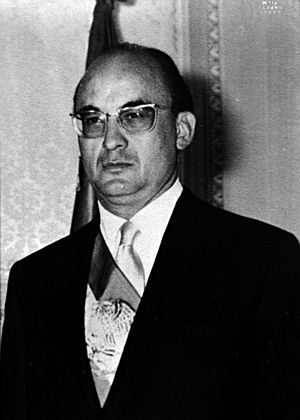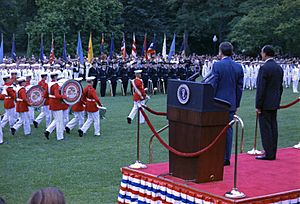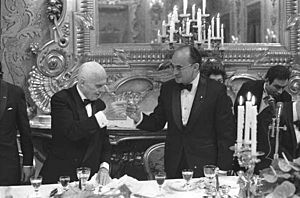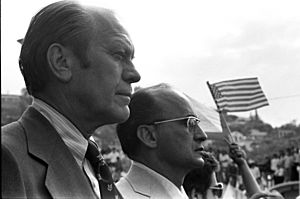Luis Echeverría facts for kids
Quick facts for kids
Luis Echeverría
|
|
|---|---|

Echeverria in 1970
|
|
| 57th President of Mexico | |
| In office 1 December 1970 – 30 November 1976 |
|
| Preceded by | Gustavo Díaz Ordaz |
| Succeeded by | José López Portillo |
| Secretary of the Interior of Mexico | |
| In office 16 November 1963 – 11 November 1969 |
|
| President |
|
| Preceded by | Gustavo Díaz Ordaz |
| Succeeded by | Mario Moya Palencia |
| Personal details | |
| Born |
Luis Echeverría Álvarez
17 January 1922 Mexico City, Mexico |
| Died | 8 July 2022 (aged 100) Cuernavaca, Morelos, Mexico |
| Political party | Institutional Revolutionary |
| Spouse |
María Esther Zuno
(m. 1945; died 1999) |
| Children | 8 |
| Education | National Autonomous University of Mexico (LLB) |
Luis Echeverría Álvarez (born January 17, 1922 – died July 8, 2022) was a Mexican lawyer and politician. He belonged to the Institutional Revolutionary Party (PRI). Echeverría served as the 57th president of Mexico from 1970 to 1976. Before becoming president, he was the Secretary of the Interior from 1963 to 1969.
During his time as Secretary of the Interior, there was a rise in political control. This included the Tlatelolco massacre on October 2, 1968. In this event, many unarmed student protesters were killed by the Mexican Army. Echeverría later became president in the 1970 election.
As president, Echeverría tried to make Mexico a leader among "Third World" countries. These were nations not allied with the United States or the Soviet Union during the Cold War. He welcomed refugees from Chile and started strong ties with China. He also supported a UN resolution that caused tension with Israel.
Mexico's economy grew well during his presidency, helped by high oil prices. Echeverría also started big building projects. However, his time in office also saw events like the 1971 Corpus Christi massacre against student protesters. There was also a period of conflict against opposition groups. Near the end of his term, Mexico faced an economic crisis.
Contents
Luis Echeverría: Mexico's President
Early Life and Career
Luis Echeverría was born in Mexico City on January 17, 1922. His parents were Rodolfo Echeverría and Catalina Álvarez. In 1947, he began teaching at the National Autonomous University of Mexico. He taught about political ideas and law. He rose through the ranks of the Institutional Revolutionary Party (PRI). He eventually became the private secretary to the party president.
Becoming Secretary of the Interior
Echeverría served as Deputy Secretary of the Interior. This was during Adolfo López Mateos's presidency. Gustavo Díaz Ordaz was the main Secretary of the Interior then. When Díaz Ordaz left his role in 1963, Echeverría took over as Secretary of the Interior. He continued in this position when Díaz Ordaz became president. He stayed in this role until November 1969.
The Tlatelolco Event
In 1968, Echeverría took a firm stance against student protests. The conflicts between the government and protesters ended with the Tlatelolco massacre. This happened in October 1968, just before the 1968 Summer Olympics in Mexico City.
Presidential Election in 1970
On October 22, 1969, President Díaz Ordaz announced Echeverría as his chosen successor. Echeverría was officially named the presidential candidate on November 8, 1969. Even though he had been tough on protesters, he tried to change his image after becoming a candidate.
Leading Mexico (1970–1976)

Echeverría was the first president born after the Mexican Revolution. As president, he started many new programs. He took control of the mining and electrical industries for the government. He also gave land to farmers and limited foreign investments. Mexico's maritime zone was also expanded. The government spent more money on health, housing, education, and food support. This helped more people get social security.
On October 8, 1974, Echeverría created two new states: Baja California Sur and Quintana Roo. These had been federal territories before.
Economic Challenges
After many years of economic growth, Echeverría's government faced an economic crisis. This happened in his final months in office. Mexico's foreign debt grew from $6 billion in 1970 to $20 billion in 1976.
For many years, the value of the peso was stable against the U.S. dollar. But on August 30, 1976, the Echeverría government lowered the peso's value by almost 60%. Two months later, its value was lowered again. Despite these issues, the Mexican economy still grew by 6.1%. Important building projects were also finished.
Changes in Elections
During Echeverría's time, a new election law was passed. It made it easier for political parties to be officially recognized. It also created a permanent voting card. The minimum age to run for elected office was lowered to 21.
Echeverría chose his finance minister, José López Portillo, to be the next presidential candidate. This was a tradition in the PRI party. In the 1976 elections, López Portillo was the only candidate. This was because the main opposition party, PAN, had internal problems and did not nominate anyone. So, López Portillo won the election without anyone running against him.
Environmental Efforts

In 1971, Echeverría's government passed Mexico's first national environmental law. This law aimed to control air pollution and set new water quality standards. A new government agency was also created to focus on environmental issues.
Ban on Rock Music
After student protests, President Echeverría tried to control young people. In late 1971, after the Corpus Christi massacre and a rock festival, he banned most rock music by Mexican bands. This ban stopped recordings, sales, live concerts, and radio play of Mexican rock. International rock music was less affected at first. But after a 1975 concert by the band Chicago ended in trouble, Echeverría temporarily banned all American music concerts in Mexico. The ban on Mexican rock music lasted for many years. It only slowly began to be lifted in the 1980s.
Foreign Policy

Echeverría changed Mexico's foreign policy to focus on "Third Worldism." He showed support for developing nations. He tried to make Mexico a leader for these countries. His goals were to expand Mexico's economic ties and work for a fairer world order.
He visited many countries and had strong relationships with Cuba and Chile. Mexico also offered a safe place for many political refugees from South American countries. He also spoke out against Zionism. He allowed the Palestine Liberation Organization to open an office in Mexico City.

Echeverría helped promote the Declaration of Mexico on the Equality of Women. This was adopted at the 1975 World Conference on Women in Mexico City. In 1975, Mexico also voted for a UN resolution that caused a tourism boycott by the U.S. Jewish community against Mexico.
Echeverría's presidency also dealt with anger from people in Northwestern Mexico. This was about the United States' use of water from the Colorado River. The river water crossing into Mexico had become very salty. This damaged large areas of farmland.
Trying to Lead the United Nations
In 1976, Echeverría tried to become Secretary-General of the United Nations. The current Secretary-General, Kurt Waldheim, was seeking a second term. China, however, wanted someone from a "Third World" country to lead the UN. Echeverría entered the race on October 18, 1976. However, he lost by a large number of votes. The Security Council voted on December 7, 1976. Echeverría received only 3 votes, while Waldheim got 14.
After the Presidency
Continued Influence and Accusations
After leaving office, Echeverría still tried to influence Mexican politics. He appointed some officials for the new president, José López Portillo. However, López Portillo's team worked to reduce Echeverría's influence.
Echeverría served as ambassador to Australia and New Zealand from 1978 to 1979. Later, President Carlos Salinas de Gortari (1988-1994) accused Echeverría of causing political problems.
In 2002, Echeverría was called to testify about the Tlatelolco massacre of 1968. On July 23, 2006, a special prosecutor asked for his arrest. This was for his alleged role in the Corpus Christi massacre on June 10, 1971. In this event, students were attacked during a protest in Mexico City.
On November 29, 2006, a Mexican judge ordered Echeverría to be under house arrest. However, on March 26, 2009, a federal court cleared him of the charges related to the Tlatelolco events.
Personal Life and Death
Luis Echeverría married María Esther Zuno on January 2, 1945. They had eight children together.
Echeverría turned 100 years old on January 17, 2022. He passed away at his home in Cuernavaca on July 8, 2022. He was cremated in a private ceremony on July 10.
Legacy and Public Opinion
Many people in Mexico have strong feelings about Echeverría. Some blame him for the economic problems Mexico faced. Others criticize his role in the 1968 student massacre.
In a 2012 survey about former presidents, 27% of people thought Echeverría's time in office was "very good" or "good." However, 46% thought it was "very bad" or "bad." He was the second-lowest rated former president in that survey.
Honours and Awards
 Grand Master of the Order of the Aztec Eagle, Mexico (1970–1976)
Grand Master of the Order of the Aztec Eagle, Mexico (1970–1976) Honorary Knight Grand Cross of The Most Honourable Order of the Bath (1973)
Honorary Knight Grand Cross of The Most Honourable Order of the Bath (1973) Knight Grand Cross with Collar of the Order of Merit of the Italian Republic, Italy (8 February 1974)
Knight Grand Cross with Collar of the Order of Merit of the Italian Republic, Italy (8 February 1974) Great Star of the Decoration of Honour for Services to the Republic of Austria (1974)
Great Star of the Decoration of Honour for Services to the Republic of Austria (1974) Honorary Member of the Order of Jamaica
Honorary Member of the Order of Jamaica
See also
 In Spanish: Luis Echeverría Álvarez para niños
In Spanish: Luis Echeverría Álvarez para niños


